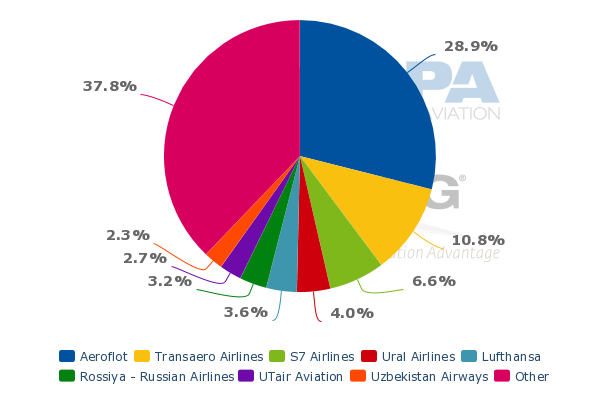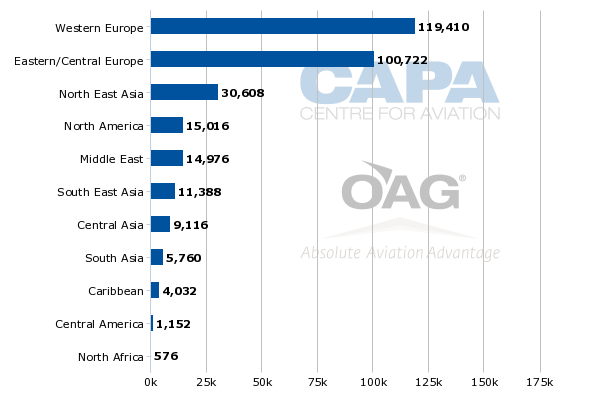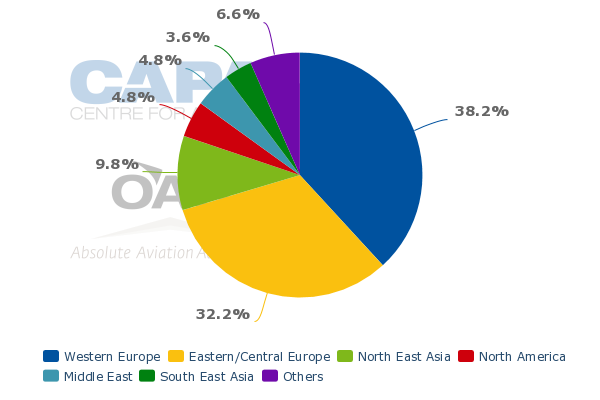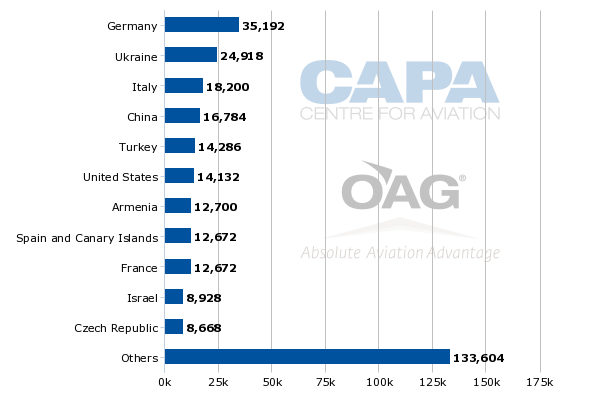Aeroflot unable to join SkyTeam's trans-Atlantic JV but seeks new option and JVs to Europe & Asia
Aeroflot is seeking to downplay reports from earlier in 2013 that it was considering leaving its SkyTeam alliance, to which it has belonged since 2006. But its relations with the alliance have become strained. Air France-KLM and Delta blocked Aeroflot's request to join their trans-Atlantic joint-venture, Aeroflot Deputy Director for Strategy and Alliances Giorgio Callegari told CAPA at its World Aviation Summit in Amsterdam on 26/27-Nov-2013. Mr Callegari declined to say why Aeroflot was not permitted to join, but said SkyTeam is "basically run by Air France-KLM and Delta" and Aeroflot "belongs in name only".
Mr Callegari's views on certain airlines dominating an alliance are not unique to Aeroflot or SkyTeam. The question for Aeroflot is "where do we go from here?" Mr Callegari said. His answer is to establish bilateral relationships, and namely joint-ventures, in Aeroflot's three key markets, in order of importance: Europe, Asia and North America. Mr Callegari reported "good" relations with SkyTeam's Asian partners, potentially meaning they could be part of a JV. But Aeroflot will likely have to turn to non-SkyTeam members if it is to establish a JV of significant weight in Europe and North America. Such numerous and strong JVs outside of an alliance would be unprecedented, and fuel more speculation about Aeroflot's future in SkyTeam.
Some 47% of Aeroflot's Dec-2013 seat capacity is allocated to the domestic market, making it a major focus in addition to its various international markets. In the domestic market the biggest changes for Aeroflot are consolidation and a forthcoming LCC. These will be examined in a future report.
Aeroflot had been reported ready to leave SkyTeam
In mid-2013 local reports began to emerge out of Russia citing unnamed sources that Aeroflot was considering leaving the SkyTeam alliance. Although that would be accompanied by an exit fee, it would be significant for alliances as Aeroflot (excluding its numerous subsidiaries) accounts for 28% of the Russian domestic market and 29% of the international market, according to OAG data for Dec-2013. oneworld has smaller S7 as a member while Star has no Russian member.
Russian Federation domestic seat capacity by carrier: 2-Dec-2013 to 8-Dec-2013

Russian Federation international seat capacity by carrier: 2-Dec-2013 to 8-Dec-2013

The reports again cited unnamed sources saying Aeroflot was particularly unhappy with Delta's fees, likely a reference to codeshare and interline agreements. Also mentioned was Aeroflot being unhappy with frequent flyer policies.
Aeroflot in Jul-2013 was reported to have commissioned a study by the Oliver Wyman Group to assess the benefits of being a SkyTeam member. In Sep-2013 Aeroflot board said it had decided for Aeroflot to remain in SkyTeam, one of the rare official statements Aeroflot made about there being any doubt. In a statement Aeroflot's board noted the benefit of SkyTeam membership and said that Aeroflot would increase its involvement in SkyTeam and should maximise partnerships with other SkyTeam airlines.
That language shifted in Oct-2013 when Aeroflot called on SkyTeam to lift restrictions on cooperation with airlines from alliances outside of SkyTeam, in other words oneworld and Star although no specific airlines were mentioned. Aeroflot re-affirmed its view it would remain in SkyTeam but said economic conditions should allow external activity.
Alliances to varying degrees restrict non-alliance partnerships
The sentiments Aeroflot is getting to is that alliance membership can come with a price: exclusivity. Alliances to varying degrees can restrict partnerships with other airlines, and especially those from another alliance. In theory this allows for cohesion and partnership benefits to remain within the alliance. This causes conflicts if a member wants to partner with a fellow alliance member that is unwilling or if a partnership is being sought in a region the alliance cannot cover.
Star Alliance is the most dogmatic. One of the most recent examples is Air New Zealand in Nov-2013 saying it could not expand its partnership with Cathay Pacific due to Star rules, even though there is no suitable Star alternative in Hong Kong. oneworld is the most flexible, and International Airlines Group CEO Willie Walsh said the CAPA summit that if it were not for that flexibility then IAG would not be a member of oneworld.
Nor do all alliance members have equal say
Alliances can present themselves as single equitable entities. Indeed, many airlines often join expecting to be part of the club on equal terms but then discover they do not have an equal voice. This is especially true for smaller airlines, which have recently been the typical additions to alliances.
Star for example has three membership levels, with the lowest option corresponding to a lower membership fee but also less say. The rationale is that a small airline with lower revenues does not have to pay the same as the largest member. Reduced say provides an incentive for an airline to upgrade its level, but also reflects that rules should be determined in proportion to impact. Airlines do not always find this to be conducive, and the membership tiers can be contentious. Air China said that in 2012 it upgraded its membership from Class 2 to Class 1. The alliances rarely talk about the differences and what airline is of what status.
Aeroflot was not permitted to join trans-Atlantic JV
Mr Callegari said Aeroflot wanted to join the trans-Atlantic JV led by Air France-KLM and Delta but was not permitted. The carriers have expanded their JV, bringing Alitalia in, but did not want to expand it to Aeroflot. Mr Callegari did not want to specify the reasons since he did not want to speak on behalf of the other airlines.
The only other known example of a major airline being excluded from a JV with fellow alliance partners is US Airways not being invited to join Star's trans-Atlantic JV, ostensibly because US Airways' revenues were too low and would drag down performance for the other carriers. The JVs generally share revenue in proportion to the capacity they put in.
It is unknown if revenue concerns could be a factor against Aeroflot, which is known for competitive North America-Europe fares despite the circuity of connecting in Russia. While sixth-freedom traffic is a noticeable part of Aeroflot's business, it accounts for a minority of passengers.
Aeroflot in Dec-2013 is the 19th largest airline between North America and Europe but this equates to a 1% marketshare. The JV from Air France-KLM, Alitalia and Delta accounts for 22% of the market. Airlines smaller than Aeroflot, such as Austrian and Finnair, are part of the Star and oneworld JVs respectively. Between Russia and North America, Aeroflot accounts for a dominating 59% share of capacity. Transaero accounts for 17%, Delta 13% and Singapore Airlines 11%. Aeroflot has little non-stop competition but there are a plethora of one-stop options.
Despite being unable to join the JV, Aeroflot is increasing relations with Delta. In Nov-2013 the two applied to regulators to increase codeshare flights, including on Aeroflot's Miami-Moscow services. The codeshare dates back to 2011.
While reports indicated the relations with Delta were a major factor for Aeroflot to be displeased with the status quo, Mr Callegari says a JV in North America is the third most important one. This is logical as North America is Aeroflot's third-largest region behind Europe and Asia (Northeast and Southeast combined).
Aeroflot international seat capacity by region: 2-Dec-2013 to 8-Dec-2013

Aeroflot international seat capacity share by region: 2-Dec-2013 to 8-Dec-2013

What Aeroflot's options are is not clear. No other US carrier is flying to Russia, although that could theoretically change if a partnership with the largest player is offered, but this would need to be worked around existing alliance partnerships. While awkward, it is not unprecedented as Delta is forming a JV with Virgin Atlantic to supplement its one with SkyTeam partners, who are not necessarily happy with the Delta-Virgin deal.
Aeroflot could change its approach to a partnership with a US carrier for North American feed. JetBlue is based at Aeroflot's largest US point of New York JFK and has numerous receiving codeshares and interlines and has recently started to place its code on other flights. Virgin America is less aggressively pursuing a partnership strategy but is based at Aeroflot's second-largest North American destination of Los Angeles.
North American Airports Aeroflot serves ranked on seat capacity: 2-Dec-2013 to 8-Dec-2013
| Rank | Airport | Total Seats | |
|---|---|---|---|
| 1 | JFK | New York John F Kennedy International Airport | 8,064 |
| 2 | LAX | Los Angeles International Airport | 3,456 |
| 3 | MIA | Miami International Airport | 1,728 |
| 4 | IAD | Washington Dulles International Airport | 884 |
| 5 | YYZ | Toronto Pearson International Airport | 884 |
A JV in Europe is most important to Aeroflot
The most important JV for Aeroflot that Mr Callegari identified was one covering Europe. Western Europe accounts for 38% of Aeroflot's international seat capacity while Western Europe with Central and Eastern Europe covers 70% of Aeroflot's international seat capacity.
Aeroflot's strategy is not entirely clear except that Russia has the largest domestic market in Europe (larger than Germany) and Aeroflot is worrying about market share now that foreign airlines are increasing capacity and foreign LCCs are entering. But a single partnership could be difficult given the fragmented nature of the European market. Germany is Aeroflot's single largest foreign market, and accounts for 29% of Aeroflot's Western European network.
Aeroflot is entering relatively uncharted waters but there are surely opportunities of many permutations. There are few guiding examples given the limited number of short-haul JVs. Where short-haul JVs do exist (for example: Air China-Cathay Pacific for China-Hong Kong travel; Air New Zealand-Virgin Australia for New Zealand-Australia travel), they tend to focus on two specific markets rather than multiple countries.
There will be barriers, but not insurmountable, for Aeroflot. Intra-Europe flights are a challenge for European airlines, which have been understandably preoccupied with cost-cutting measures. Revenue-generating opportunities are less discussed but with time could see creative solutions that also cross alliance lines, such as pushes for airberlin to codeshare with Air France. Aeroflot and its European peers approach Europe differently: for Aeroflot Europe is relatively healthy with strong local traffic to/from Russia, but for European carriers Europe services are broadly seen as feed for profitable long-haul flights, which capture focus.
Russia is close to but also different from Europe, and undoubtedly at many European airlines the Russian market has been caught in the dichotomy of thinking about the world in a Europe or long-haul dichotomy. Russia's tight bilateral regime as well as Aeroflot's at times reclusiveness did not help.
A partnership invitation from Aeroflot will change these views, resulting not just in a potential partnership for Aeroflot but an airline's realisation it should boost its own standing in Russia. But with Aeroflot's heavy hand on aeropolitical matters, competitors could struggle to achieve gains if plans do not include Aeroflot.
Aeroflot international seat capacity by country: 2-Dec-2013 to 8-Dec-2013

Asia is Aeroflot's second-most important market for a JV; relations with Asian SkyTeam members are good
Aeroflot serves 12 points in Northeast and Southeast Asia, which Mr Callegari identified as the second-most important market for Aeroflot to form a JV in. Mainland China is Aeroflot's largest market by far, accounting for 40% of capacity. Aeroflot serves three points (its largest of any Asian country): Beijing, Shanghai and Guangzhou. Beijing and Shanghai are its two largest destination cities.
Northeast/Southeast Asian Airports Aeroflot serves ranked on seat capacity: 2-Dec-2013 to 8-Dec-2013
|
Rank |
Airport |
Seats |
|
|
1 |
7,126 |
||
|
2 |
6,778 |
||
|
3 |
5,628 |
||
|
4 |
4,320 |
||
|
5 |
4,032 |
||
|
6 |
4,032 |
||
|
7 |
2,880 |
||
|
8 |
2,304 |
||
|
9 |
1,728 |
||
|
10 |
1,728 |
||
|
11 |
864 |
||
|
12 |
576 |
Aeroflot is fortunate that China is dominated by the SkyTeam alliance, which comprises 43% of domestic seat capacity. An unknown factor is if Chinese SkyTeam members China Eastern and China Southern would feel awkward about partnering with Aeroflot since the two have JVs (albeit narrow) with Air France-KLM. Aeroflot targets sixth-freedom traffic to/from China, potentially making Aeroflot's success in partnership with China Eastern and China Southern a detriment to Air France-KLM. The Russia-China market is unique, both due to geography (Air France-KLM are carrying an insignificant number of passengers from China to Russia via Paris/Amsterdam) and local traffic.
But China is not Aeroflot's sole focus in Asia. While other SkyTeam carriers have reported difficulties in establishing a relationship with Korean Air, Mr Callegari says Aeroflot has a "good" relationship with Korean Air specifically as well as with other Asian members of SkyTeam. While South Korea and Vietnam have local SkyTeam carriers, there is no local SkyTeam carriers in Japan, Hong Kong, Mongolia or Thailand.
The Asian market is not as fragmented for Aeroflot as Europe, but nor could a single JV blanket the region, as the trans-Atlantic one could have for North America. A Chinese one, however, could come close since Chinese carriers are growing their regional Asian networks. The strength for now would be in North Asian countries given the geography of Chinese carriers' hubs, which are concentrated along China's east coast. Connections to Southeast Asia from those hubs have a high degree of circuity. Inland Chinese hubs would be more favourable for Southeast Asian connections, but these hubs are still maturing. Another factor is that the regulatory environment for JVs in Asia is also less defined than in Europe or North America.
Aeroflot accounts for a growing 40% of the China-Russia market.
China and Russia seat capacity by carrier: 19-Sep-2011 to 8-Jun-2014
The partnership value in Global Alliances is shifting to closed JVs
Aeroflot's quest for joint ventures underscores how the value of partnerships is moving from global alliances to JVs, although most - but not all - of the JVs originate from within alliances.
Alliances are (again) at a cross-roads, and Aeroflot appears to have entered right at this moment. Forming JVs outside an alliance do not mean a carrier no longer sees value in its alliance, as the hybrid Emirates-Qantas and Air New Zealand-Cathay Pacific partnerships show, for example. But such moves will certainly fuel speculation about Aeroflot. Alliances are about business, not pride, so there may very well come a time when switching alliance partners or becoming unaligned (as Aer Lingus did) becomes logical.
Aeroflot's perceived weak reception by SkyTeam is another example of airlines being frustrated by their alliance's typical US-European anchoring and seeking to shift it. Alliances can be global in emphasis but can become an exclusive old boys' club in focus.
JVs may provide Aeroflot with a number of answers. But they will also spawn new challenges, such as managing its various close partners that undoubtedly overlap to a degree with each other. Air France and Delta have had their own squabbles with partners, but potential Aeroflot suitors will wonder how much of the blame in the trans-Atlantic JV attempt is to be cast on Aeroflot.
In the European market where Aeroflot most wants a JV, the airline will also have to experiment with what a short-haul JV is and how it can work; there are few precedents. It may end up creating some. Sometimes it needs an outsider - in this case with its large domestic market - to change views.
